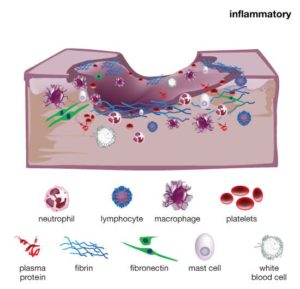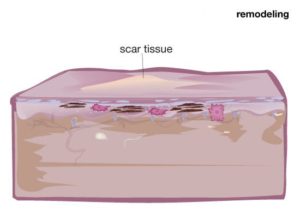After falling down and cutting your knee you wonder, “how is my body going to be able to heal after developing such a large wound?”.
In order for your body to heal adequately it must undergo three phases of wound healing. Each of these three phases known as the inflammatory, proliferation and maturation phases are all required to ensure that your body heals and returns back to its normal function. To help understand these different phases a little better I will break down each process.
- Inflammatory Phase

Whenever you injure yourself or find yourself sick, your body creates an immune response to assist in your body detecting that a foreign body is present. After the initial wounding, blood vessels within the wound bed contract, this results in a clot being formed to prevent continuous bleeding occurring. Once haemostasis (a balance within the body) has been reached the surrounding blood vessels will dilate to allow essential cells such as antibiotics, white blood cells, growth factors, enzymes and required nutrients to reach the wound.
Within the inflammatory phase macrophages, neutrophils and phagocytic cells produce a host response to remove and eat away at any necrotic (dead and blackened tissue) and sloughy tissue which will prevent and delay the wound from healing. While this phase is happening inside your body you may notice signs of erythema (redness of the skin), heat, oedema (swelling caused by fluid retention) and pain within and around the wound’s surrounding areas.
- Proliferation Phase

During the proliferation phase the wound begins to rebuild itself with new granulation tissue which is pink/red in colour. This tissue is made up of collagen and the extracellular matrix as well as a new network of blood vessels. In order for healthy granulation tissue to be formed and maintained it becomes dependent upon fibroblasts (The principal active cells of connective tissue) receiving an adequate amount of oxygen and nutrients being supplied to the blood vessels.
- Maturation Phase

The final phase of wound healing, also known as remodeling, occurs when the wound is closed entirely. While the majority of individuals will believe that the wound has healed once closed it may take up to two years before it has completely healed. The amount of cellular activity occurring at the wound site reduces as well as the number of blood vessels. The dermal layer of skin begins to regain strength to ensure that the wound does not continue to break down easily.
Next time you develop a wound on your foot or leg it is important to take the appropriate steps to avoid infection occurring and to allow your wound to heal appropriately. If you have developed a non-healing wound or are concerned about a wound that has recently developed, book in today to see one of our friendly, skilled podiatrists for an assessment. You can call 03 8645 9800 to book an appointment or
Image Reference: http://www.atitesting.com/ati_next_gen/skillsmodules/content/wound-care/equipment

